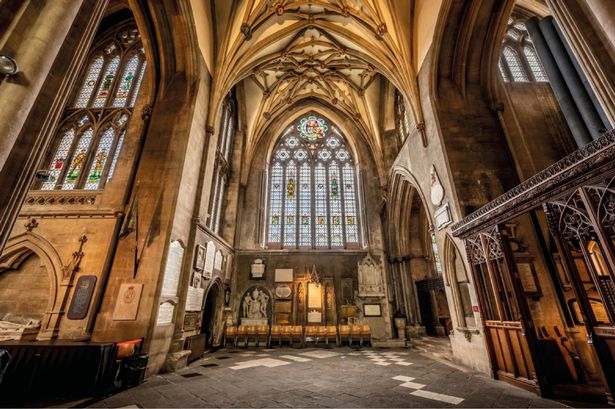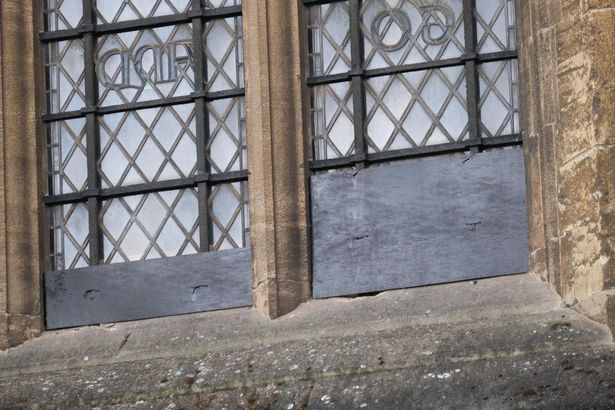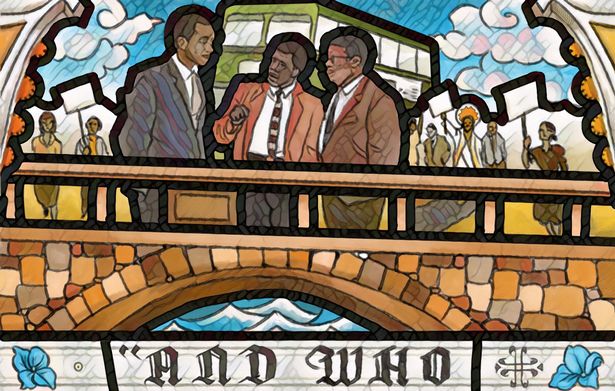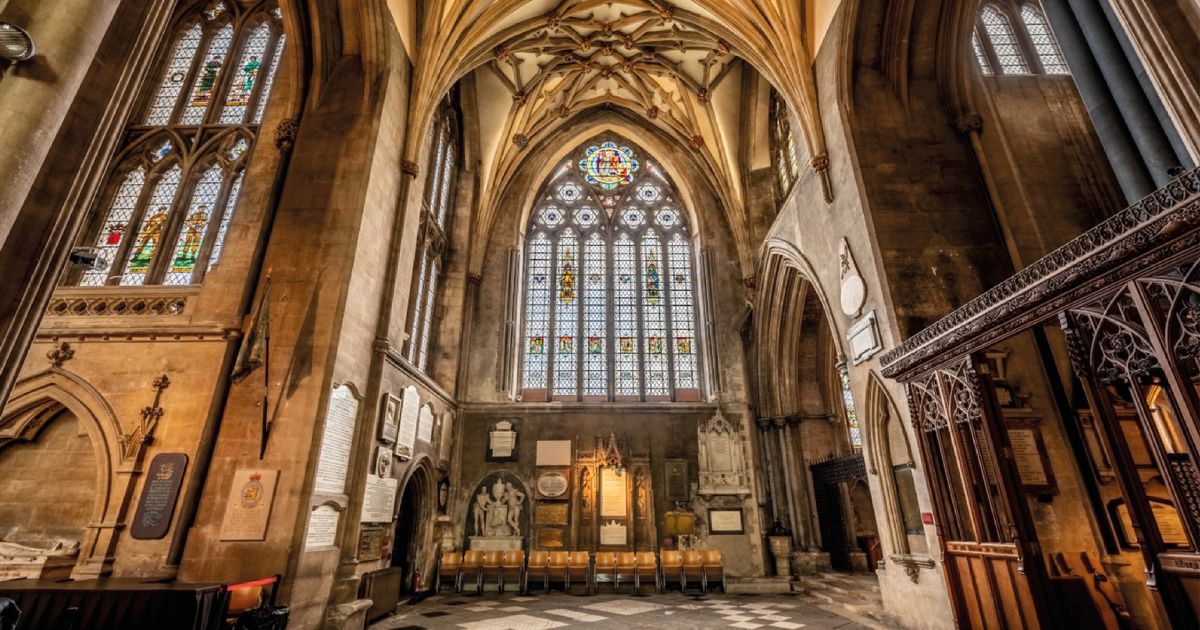In ‘dialogue with’ the window commemorating slave trader Edward Colston The north transept of Bristol Cathedral, which includes a large stained glass window dedicated to slave trader Edward Colston. The Cathedral plan to install a permanent work of art that ‘honours the resilience, culture, and faith of African and Afro-Caribbean communities in Bristol’ in the area(Image: Bristol Cathedral)
The north transept of Bristol Cathedral, which includes a large stained glass window dedicated to slave trader Edward Colston. The Cathedral plan to install a permanent work of art that ‘honours the resilience, culture, and faith of African and Afro-Caribbean communities in Bristol’ in the area(Image: Bristol Cathedral)
A ‘significant’ new work of art is to be permanently installed inside Bristol Cathedral, in front of a stained-glass window that commemorates the slave trader Edward Colston.
The permanent artwork will ‘celebrate the resilience, culture and faith of African and Afro-Caribbean communities in Bristol’, and the cathedral is opening up applications for artists to come up with ideas and potentially be commissioned to create the work of art, which will then be installed and form an integral part of the Grade I-listed building.
Cathedral bosses said they were keeping the stained-glass window which honours Edward Colston, but the artwork would be ‘in dialogue’ with the memorial.
“The commission invites creative responses to be installed in the Cathedral’s north transept, in dialogue with the existing Edward Colston memorial window,” a spokesperson said.
“Artists are invited to sign up for an Ideas Lab on Friday, July 18, where they will hear more about the vision for the work and the application process. This commission forms part of the Cathedral’s wider commitment to racial justice, reconciliation, and truth-telling,” she added.
“The project builds on previous initiatives, including All God’s Children, a long running exhibition that explores the impact of the transatlantic slave economy on the Cathedral’s life, past and present. Based on extensive research into memorialised individuals connected to slavery, the exhibition invited public feedback on how the Cathedral should respond,” she said.
Bristol Cathedral has had long links with the Society of Merchant Venturers and the slave trade, hosting church services and school commemoration services for the slave trader for decades, up until the late 2010s.
READ MORE: Buns, sermons and slave songs – how slave trader Edward Colston was awkwardly commemorated on Anti-Slavery DayREAD MORE: Edward Colston’s name removed from Bristol Cathedral and St Mary Redcliffe
In 2014, the then Bishop of Bristol Mike Hill gave a sermon to the Merchant Venturers’ Charter Day service in which he said there ‘may be still some speculation on some of the circumstances around his business roots’ – a remark recorded by journalist Tony Gosling, that sparked controversy and ultimately the founding of the Countering Colston campaign in the following year.
It was only after the statue of Edward Colston was toppled in 2020 that cathedral bosses committed to what they described as ‘a series of racial justice actions, including confronting the Church’s ties to slavery’.
 (Image: Jon Kent/Bristol Live)
(Image: Jon Kent/Bristol Live)
The first act was to cover up the Colston window, in part to protect it, but the cathedral then adopted its own Racial Justice Strategy, which ‘includes making the cathedral more welcoming to all, regardless of heritage, gender, sexuality or disability’.
In 2022, a temporary exhibition opened called All God’s Children, which shared new research on the cathedral’s memorials and wealth linked to enslavement.
A consultation formed part of that, and the majority of people did not want the Colston window to be removed, but called for who he was and what he did to be better contextualised.
READ MORE: Bristol church to install ‘multi-ethnic Jesus’ stained glass windows instead of ‘grotesque’ ColstonREAD MORE: Colston statue toppling five years on – we ask what difference it made
“Feedback from the exhibition showed that while most visitors do not support removing the window, they want the truth to be told about Colston’s legacy and to see the lives of African and Afro-Caribbean people celebrated in the Cathedral,” said a cathedral spokesperson.
What the artwork will look like and who will be chosen to create it is still a long way off, but the cathedral is setting up a commissioning panel to seek artists, and as a guide, the proposals artists come up with ‘may reflect acts of resistance, community and joy in the face of historic injustice, events such as the Bristol Bus Boycott or the Windrush generations, biblical and theological themes like liberation, reconciliation and resurrection or the diversity of the black diaspora and the global story of Christianity’.
Dr Edson Burton is part of the panel. “This is a great opportunity for an artist to make an impact and to tell a new story that will speak to future generations with power and encouragement,” he said.
 The new designs of stained glass windows to be installed at St Mary Redcliffe Church in Bristol, to replace a window dedicated to slave trader Edward Colston. The designs show a ‘non-white’ Jesus in a series of images that include in a boat with refugees, with the Bristol Bus Boycott campaigners(Image: Ealish Swift/St Mary Redcliffe Church)
The new designs of stained glass windows to be installed at St Mary Redcliffe Church in Bristol, to replace a window dedicated to slave trader Edward Colston. The designs show a ‘non-white’ Jesus in a series of images that include in a boat with refugees, with the Bristol Bus Boycott campaigners(Image: Ealish Swift/St Mary Redcliffe Church)
The cathedral is not the first church in Bristol to use art to acknowledge Bristol’s Black community and the city’s slavery history, following the toppling of the Colston statue.
At St Mary Redcliffe Church, which had also traditionally held church services commemorating Edward Colston until as late as 2017, a new stained glass window was unveiled in 2023 to replace its window celebrating Colston.
It included a ‘multi-ethnic Jesus’ in a variety of scenes, including ones which represented the Bristol Bus Boycott, and another showing Jesus in a boat with refugees.
